North Borneo Birding Tour
 24th August – 6th September 2025: North Borneo birding tour highlights include Bornean Bristlehead, Helmeted Hornbill, Blue-headed Pitta, Blue-banded Pitta, White-fronted (Bornean) Falconet, Black-throated Wren Babbler, Whitehead’s Trogon, Bare-headed Laughingthrush, Black-and-crimson Pitta, Bornean Ground Cuckoo, Crimson-headed Partridge, Great Argus, Fruithunter – £TBA per person
24th August – 6th September 2025: North Borneo birding tour highlights include Bornean Bristlehead, Helmeted Hornbill, Blue-headed Pitta, Blue-banded Pitta, White-fronted (Bornean) Falconet, Black-throated Wren Babbler, Whitehead’s Trogon, Bare-headed Laughingthrush, Black-and-crimson Pitta, Bornean Ground Cuckoo, Crimson-headed Partridge, Great Argus, Fruithunter – £TBA per person
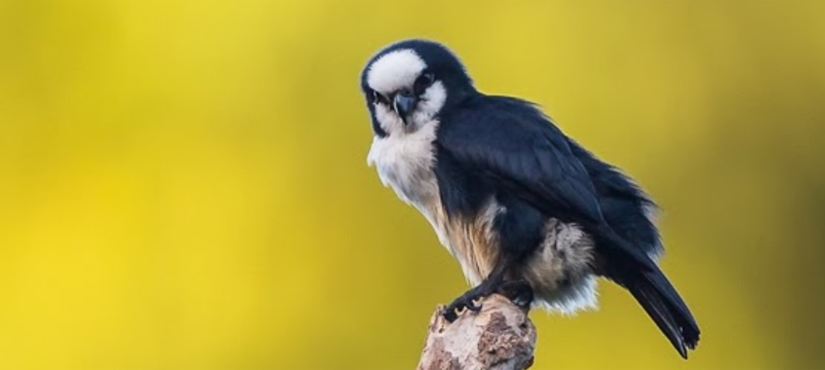
Trip Details
- Date: 24th August- 6th September 2025
- Cost: £TBA
- Single Supplement: £900
- Deposit: £660
- Tour length: 14 Days (13 days birding)
- Min / Max group size: 5 / 9
- Start/Finish: Kota Kinabalu
- Tour Type: Birding
- Photo Opps: Fair
- Physicality: Fairly easy/Moderate
- Tour Leaders: Nick Upton & Lee Kok Chung
Contact us if you have questions about this trip – info@calidrisbirdingtours.com
North Borneo Birding
Imagine yourself walking the trails through the forests on Southeast Asia’s highest mountain, visiting the home of the incredible giant bloom of the rafflesia, taking a boat trip along the tree-fringed riverside home of the incredible Proboscis Monkey, stalking rarities in the lowland forest refuge of the Danum Valley and being a guest of Asia’s great ape, the Orang Utan, in one of its last forest homes. These are the incredible scenes in which birding in Borneo takes place.
The state of Sabah occupies the northern part of the island of Borneo and is part of the nation of Malaysia. While the avifauna here has a natural affinity with mainland Southeast Asia there is a high level of endemism too which makes birding in Borneo so interesting. With this birding tour centred around four iconic birding locations, there is the minimum of travel and time in the field is at its maximum so that we can enjoy these fabulous habitats and the wildlife within them, both birds and mammals, to the full. The evolutionary pressures that have been exerted upon the flora and fauna of Borneo have resulted in many distinct species and subspecies for us to enjoy and the high probability of meeting wild Orang Utans is truly something to get excited about.
For bird watchers who want to see a wide selection of key Southeast Asian birds that are thin on the ground elsewhere as well, of course, to appreciate a high number of Borneo’s endemic birds, this birding tour is an excellent choice. This is a tour that takes in the best of the forest habitats of Borneo with exciting birds such as Whitehead’s Trogon and Whitehead’s Broadbill exist in the high altitude forests of Mount Kinabalu, while birding along the Kinabatangan river puts us into mangroves and swamp forest in search of Storm’s Stork, White-fronted Falconet and the elusive Bornean Ground Cuckoo. The lowland rain forest is full of some of the region’s most anticipated birds with hornbills, broadbills, kingfishers and enigmatic pittas including Black-crowned Pitta, Bornean Banded Pitta and Blue-headed Pitta. Habitat and species diversity is matched by the quality of the birds on this North Borneo birding tour.
Day 1, Kota Kinabalu – 24th August 2025
Arrival is planned during the day at Kota Kinabalu International Airport. You will be met at the airport and then make the short transfer to our hotel. If arrival is early enough we can do a little birding nearby. In the evening we will all have an introductory dinner and a short briefing on the tour details.
Day 2, Kota Kinabalu – Tambunan Forest – Kinabalu National Park – 25th August 2025
Leaving the city of Kota Kinabalu early we head south east into the hills to eat our picnic breakfast and obtain our first views of the forests of Borneo. Although we will be birding in the hills the altitude here is not as high as where will spend the next few days and this subtle difference means there are some key species to look for here that may be harder to find elsewhere. Our focus today is on Tambunan Forest Reserve where we expect to see our first Bornean endemics; Mountain Barbet and Bornean Barbet. These colourful birds are always easier to hear than to see but this is a good site for them as it is for both Bornean Bulbul and Bornean Leafbird both of which often frequent flowering and fruiting trees.

In these hills is the Tambunan Rafflesia centre. This gigantic bloom is endemic to this part of the world but as it rarely flowers we will have to be lucky to see it at its best. However, birding along the roads and around the centre usually produces plenty of interesting birds including the endemic Chestnut-hooded Laughingthrush in small groups and flocks of Chestnut-crested Yuhinas. These birds often join flocks that contain more widespread Southeast Asian species such as Bar-winged Flycatcher-shrike, Blyth’s Shrike Babbler and Scarlet Minivet. We intend to spend the whole morning in this area and by 9-10am we should keep our eyes out for soaring raptors which we hope will include Blyth’s Hawk Eagle. Another endemic we will look for here is Sunda Laughingthrush while we also have our first chance at the spectacular Whitehead’s Broadbill. Should we see this incredible green gem on our first morning it will be a great way to start our birdwatching trip. Other possibilities include Bornean Spiderhunter, the amazing Long-tailed Broadbill and another endemic, Black-sided (Bornean) Flowerpecker. As well as these key species we will keep an eye open for the endemic subspecies of Ochraceous Bulbul and Cinereous Bulbul both of which are split by some authorities.
After ensuring that we find the key species for this north Borneo bird watching site we will break for lunch and if we are still looking for a secretive laughingthrush or elusive barbet we can spend some time in the early afternoon to look for them. The drive to our accommodation at Mount Kinabalu takes around an hour and a half and if we arrive in time we can do some birding around the lodge which is a good location for another endemic species, the tiny Pygmy White-eye.
Days 3-5, Kinabalu National Park – 26th-28th August 2025

Mount Kinabalu is not only the highest mountain in Malaysia but is also one of the premier bird watching sites in South East Asia. The network of trails here weave through a variety of forest types that include broadleaved trees mixed with pine woodland, rhododendron, oaks and eventually into subalpine scrub and eventually above the tree line. As you can imagine with this variety of habitats and altitudes birding at Mount Kinabalu provides a wealth of exciting species to look for. We will be concentrating on Borneo endemic bird species of course, with skulking Bornean Stubtail, Mountain Wren Babbler, stunning Crimson-headed Partridge as well as Red-breasted Partridge to look for on the forest floor while gems such as Whitehead’s Trogon and Whitehead’s Broadbill illuminate the mid storey. Colourful Golden-naped Barbet emits its repetitive call from the canopy and we will also search for Bornean and Mountain Barbets too while noisy Bornean Treepie flits from treetop to treetop. Flocks of birds feeding together should include other endemic species including the weird Bare-headed Laughingthrush, Chestnut-crested Yuhina and Sunda Laughingthrush among many others. Needless to say our first day here will leave us not knowing which way to look there are so many great birds to see.

Birding at Kinabalu is not just about endemic species though with restricted range birds such as Sunda Cuckooshrike, Indigo Flycatcher and Sunda Bush Warbler to look for while we will not ignore distinctive subspecies such as that of Flavescent (Pale-faced) Bulbul that may be split in the future. There are lots of other birds that are more widespread throughout Southeast Asia for us to enjoy too such as Mountain Leaf Warbler, Temminck’s Sunbird, Black-and-crimson Oriole and Blyth’s Shrike Babbler.
Birding within these forests is never easy and we will need some patience and persistence to make the most of the fantastic birds of Mount Kinabalu. The endemic Bornean Green Magpie is another of our prime targets which sometimes joins feeding flocks alongside Sunda Laughingthrush, White-throated Fantail, Crimson-winged Woodpecker and Chestnut-headed Laughingthrush. By spending plenty of time in the forest here we will also have the best chance to locate other key targets such as Bornean Forktail lurking in small streams, the unique Fruithunter in the tree tops, Bornean Whistler sitting still in the mid storey and the striking Whitehead’s Spiderhunter.
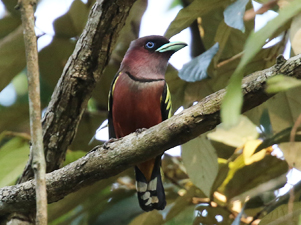
We will base ourselves in an excellent location for enjoying the best birding that Mount Kerinci has to offer, with some nice birds around the accommodation to enjoy while the option of taking short afternoon breaks in the heat of the day will also be there. One of the days we spend in this area will involve a trip to Poring Hot Springs where we can look for a wide variety of species that inhabit the lower-altitude forest at this key North Borneo birding tour site. Here we can look for White-necked Babbler, a species much reduced throughout Southeast Asia, as well as the endemic Bornean Spiderhunter and more widespread species including Fulvous-chested Jungle-Flycatcher, Yellow-bellied Bulbul, Rufous-crowned Babbler, Raffles’s Malkoha and Red-throated Barbet.
The forest here is quite dense and not as pristine as further up the mountain but at the same time we can usually get good views of birds here and it can be a good place for woodpeckers with the striking Maroon Woodpecker being a highlight but Rufous Woodpecker, Orange-backed Woodpecker and Checker-throated Woodpecker are all strong possibilities too. Other highly sought-after Southeast Asian birds that are often seen while birding at Poring Hot Springs include the incredible Crested Jay, stunning Banded Broadbill and Banded Kingfisher as well as a variety of bulbuls and babblers.
Day 6, Kinabalu National Park – Sepilok – 29th August 2025

Pre breakfast and for a short time afterwards we can do some birding close to our accommodation before we pack our things into our vehicle and start the journey towards the world famous Sepilok Orang Utan Sanctuary as well as the Rainforest Discovery Centre. The journey takes around four hours and we plan to arrive in time to enjoy our first birding session here. The mature secondary forest here provides some real highlights of birding in Borneo and although there are some really special birds awaiting us here it is highly likely that for many the highlight will be Southeast Asia’s most enigmatic forest-dweller: Orang Utan. The critically endangered Bornean Orang Utan exists here both as truly wild animals along with rehabilitated rescue animals that have graduated from the sanctuary. An experience with a wild, adult Orang Utan is truly memorable and watching these incredible apes is like observing a close relative. The translation of the word Orange Utan is “People (of the) Forest” and when you encounter them for yourself you will see how apt this name is.
While we might wax lyrical about these incredible mammals we are here for the birds. An excursion onto the canopy walkway gives us a great chance to kick off our time here with one of the key targets of any Borneo bird watching tour: Bornean Bristlehead. By no means is it guaranteed but this afternoon will be our first chance to find this iconic species and there will be plenty more chances to follow if we are not lucky on this first afternoon. Overnight at Sepilok Jungle Resort.
Day 7, Sepilok Rainforest Discovery Centre – 30th August 2025
Birding at Sepilok allows us to look for some real gems of the forest with colourful birds such as Diard’s Trogon, sitting quietly in the mid storey of the forest, to look for. The tiny Oriental Dwarf Kingfisher dwells in this forest too, often it first gives itself away with its high-pitched call, but when seen it is not easily forgotten. Similarly, the wonderful Rufous-collared Kingfisher is a bird that is very exciting to see. It is not easy to track down but we have a very good chance to spot it here; another beautiful forest kingfisher. Overhead and in the canopy we should be able to see some hornbills while on the forest floor we will have to be quiet and patient to locate Black-crowned Pitta. This highly-prized bird is tricky to see but we should have a good chance of locating it at this location.
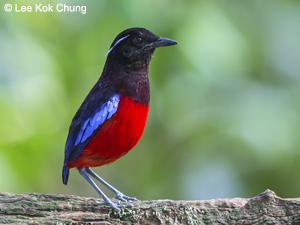
The forty three square kilometres of lush dipterocarp forest at Sepilok provide us with an exciting number of birds to search for, with a myriad of bulbuls in the forest edge and within the forest itself. Endemic Dusky Munia can be found around the more open areas while inside the forest there are even more stunning birds in store. The amazing Red-bearded Bee-eater needs to be seen to be believed while Red-naped Trogon can be added to our growing list of trogons on this tour. These colourful birds are always very exciting and memorable but we will ensure that we do not neglect the smaller and less colourful species. Black-capped Babbler with its mournful call is interesting as it creeps around on the forest floor and there should be a number of other species of babbler that are widespread in the forests of Southeast Asia.
Sepilok is famously the home of Orang Utan and we should be able to enjoy more experiences with these wonderful mammals while other mammal sightings, although hard to predict, could include the lovely Maroon Langur.
Day 8, Sepilok Rainforest Discovery Centre – Gomantong Cave – 31st August 2025
We can take a walk around to look for any species we may have missed while birding at Sepilok but by mid-morning we will be aiming to leave the area and make the journey to the vast Gomantong Cave. The forest around the cave is well-protected and we may well meet some more Orang Utans here before entering the cave where a boardwalk gives us access to a unique and weird ecosystem. While we are here for birds the cave also houses vast numbers of bats as well as even greater numbers of cockroaches!!! Don’t worry, we will observe these from a distance while we test our skills with the four species of swiftlet that use the cave as a nesting area.

Watching Mossy-nest Swiftlet, Edible-nest Swiftlet, Black-nest Swiftlet and Glossy Swiftlet swoop in and out of the cave to attend their saliva-built nests will be a great test of our skills of recognition as they are all extremely similar and will be best told by their characteristic nests within the cave. The nests vary in the amount of vegetative or feather material used within the saliva, with the most prized nests for human consumption being those of the Edible-nest Swiftlet with its nest made of nothing but saliva. This short visit to this area should provide a fascinating insight into the lives of these cryptic birds before we continue our journey towards the Kinabatangan river.
Checking into our accommodation for the next few nights we plan to have time to make our first boat trip along the river. As one might expect there are several species of kingfisher we hope to connect with so we will investigate creeks and other likely places for species such as the scarce Blue-banded Kingfisher, the richly-coloured Ruddy Kingfisher and lovely Blue-eared Kingfisher among others. We will also be looking for the Bornean subspecies of Black Magpie as a taster of what to expect tomorrow.
Day 9, Kinabatangan River – 1st September 2025
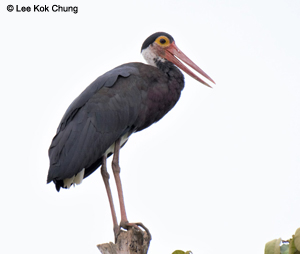
On this day our Borneo birding tour is going to provide us with something different; a boat trip along the Kinabatangan river. This is the longest river in the Malaysian state of Sabah and the waterways are lined with species rich forest within a landscape of frequently flooded swamp forest with pockets of forest on higher ground and scattered lakes. We have the full day to explore the avifauna of the Kinabatangan river, heading down the river and exploring meandering channels. One of the specialities of birding in this wonderful part of Sabah is the handsome Storm’s Stork which we hope to spot either perched atop the canopy or in flight overhead as we cruise along the river. As we glide along the waterways keep an eye out for White-fronted (Bornean) Falconet perched on an exposed snag.
This is not the only large bird we hope to encounter here with the magnificent Rhinoceros Hornbill, which is often seen flying between the largest trees, at the top of our wish list. Indeed, we have a good chance of seeing up to eight species of hornbill in this area. The colourful Black-and-red Broadbill with its pendulous nest is another memorable bird that we expect to locate but it is not just birds that we are here to see. The endemic and unique Proboscis Monkey is one of the inhabitants of this region of forest and this incredible mammal is bound to divert our attention from birding for some time.
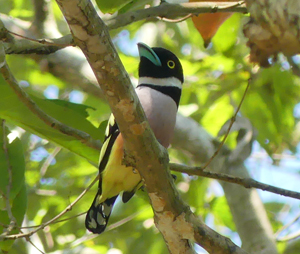
However, all our attention and patience will be required when we slowly paddle down the creeks, looking into the forest in search of one of Borneo’s most enigmatic birds; Bornean Ground Cuckoo. Although this is a very secretive, ground-dwelling bird our local guide knows how to find it and we have a good chance of seeing this almost mythical species, although we will need a little luck on our side to get a good view. Species such as the incredible Black-and-yellow Broadbill, Blue-throated Bee-eater and Asian Red-eyed Bulbul are rather easier to see and we als have a good chance to see Hooded Pitta here.
Although there has been much encroachment towards the river, there are large areas of forest and mangrove closer to the coast and we have a chance of seeing some more memorable mammals such as Bornean Pygmy Elephant, Silvered Langur or even Muller’s Bornean Gibbon. The lower, wider sections of the river are a great place for us to see a lot of wetland birds such as colourful Stork-billed Kingfisher, reptilian Lesser Adjutant, weird, snake-necked Oriental Darter, a variety of egrets as well as some exciting raptors including both Lesser and Grey-headed Fish Eagles which we can spot either in flight or perched on waterside branches.
We will also take the time to do some birding around our accommodation with the stunning Black-crowned Pitta at the top of our wanted list here. Species which are widespread in Southeast Asia, such as Orange-bellied Flowerpecker, Dark-necked Tailorbird and Chestnut-winged Babbler can be found around here as well as the endemic White-crowned Shama and Maroon-breasted Philentoma, a species that can be hard to find across much of its range. In this area we can also do some nocturnal birding with the impressive Large Frogmouth, Brown Wood Owl and Buffy Fish Owl potential target species for those with the energy to look for them.
Day 10, Kinabatangan – Danum Valley – 2nd September 2025
If we are still looking for any of the key birds of Kinabatangan river we might take another trip to look for them. Alternatively we may head straight for Danum Valley to begin our birding at this famous Bornean birding site. What we do exactly on this day will depend on what we have seen previously and what we want to focus on in the next few days. This day gives us a little flexibility on what we do. Whatever our decision on this day we will spend the night at Danum Valley, in a setting within the pristine forest that holds so many exciting birds at Borneo Rainforest Lodge .
Days 11-12, Danum Valley – 3rd-4th September 2025
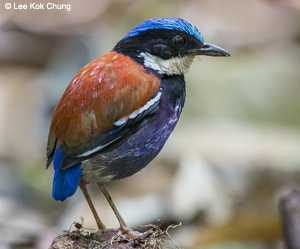
Danum Valley is one of the most famous bird watching sites in the whole of Southeast Asia and for good reason. Primary lowland forest here holds a mouth-watering selection of birds including several species of pittas, broadbills and trogons; in other words, some of the most memorable birds of the region. Sometimes it can be difficult to access such pristine forest but birding at Danum Valley benefits from a good network of trails and canopy walkways giving us the opportunity to see birds from the forest floor all the way up to the crown of the trees.
If we have not already seen it this is an excellent place for us to look for the iconic Bornean Bristlehead, no birding tour of Borneo would be complete without targeting this endemic species. Other endemic birds of Borneo for us to look for here include the smart and noisy Black-throated Wren Babbler, handsome White-crowned Shama, tiny Yellow-rumped Flowerpecker, Bornean Blue Flycatcher and Bornean Wren Babbler. This collection of endemic birds is exciting but more widespread species such as glorious Green Broadbill and Scarlet-rumped Trogon are equally mesmerizing birds. These and a large number of commoner birds will certainly keep us occupied throughout our time birding at Danum Valley.
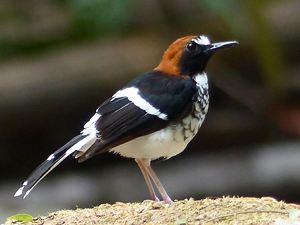
There are a jaw-dropping number of pitta species inhabiting these forests but to see them all would require a miracle. However, we intend to target three species that we have a good chance of finding; the superb Bornean Banded Pitta, the intensely-coloured Black-crowned Pita, bright red Blue-banded Pitta and the incredible Blue-headed Pitta. These, of course, are difficult birds to find but we feel that there is a high chance of making this a very memorable birding tour for pittas. While looking for these specialities on the forest trails we may also be lucky enough to come across Great Argus, a secretive bird but one that is seen here more frequently than at most other locations in the region.
The quality of the habitat at Danum Valley means that there are a wide range of species for us to search for including Bornean Crested Fireback while Rhinoceros Hornbill is a frequent sight and sound as it flies overhead. The huge trees here mean that there are lots of nest cavities for hornbills to use while some of these are created by the prehistoric-looking Great Slaty Woodpecker. With other birds here including Olive-backed Woodpecker, the jewel-like Oriental Dwarf Kingfisher, Chestnut-naped Forktail, the mighty Great-billed Heron and Blyth’s Hawk Eagle Danum Valley will provide a great ending for our Borneo birding tour.
Day 13, Danum Valley – Lahad Datu – Kota Kinabalu – 5th September 2025
We can do a little pre-breakfast birding to look for any species that we might not have seen previously. After breakfast we will say our farewell to the forest at Danum valley and transfer to the town of Lahad Datu from where we take a short flight back to Kota Kinabalu and a little birding close to the city to look for Blue-naped Parrot before finishing our Borneo birding tour in a comfortable hotel and a final dinner together with time to reflect upon the fantastic birds of Borneo that we enjoyed together.
Day 14, Departure – 6th September 2025
Transfer between our hotel and the airport will be arranged by taxi to conclude this North Borneo birding tour.
Below is a list of what we think are the key species on this North Borneo birding tour in respect of them being highly memorable and/or endemic species. We cannot guarantee that we will see all of these birds as many of them are rare and shy, but we will put in the effort to find them and expect to locate a high proportion of them based on the experience of previous visits.
- Red-breasted (Bornean) Partridge – Arborophila hyperythra
- Chestnut-necklaced Partridge – Arborophila charltonii
- Great Argus – Argusianus argus
- Crimson-headed Partridge – Haematortyx sanguiniceps
- (Bornean) Crested Fireback – Lophura ignita (ignita)
- Bornean Ground Cuckoo – Carpococcyx radiceus
- Whiskered Treeswift – Hemiprocne comata
- Storm’s Stork – Ciconia stormi
- Red-naped Trogon – Harpactes kasumba
- Diard’s Trogon – Harpactes diardii
- Whitehead’s Trogon – Harpactes whiteheadi
- Scarlet-rumped Trogon – Harpactes erythrocephalus
- White-crowned Hornbill – Berenicornis comatus
- Bushy-crested Hornbill – Anorrhinus galeritus
- Black Hornbill – Anthracoceros malayanus
- Rhinoceros Hornbill – Buceros rhinoceros
- Helmeted Hornbill – Rhinoplax vigil
- Bornean Brown Barbet – Caloramphus fuliginosus
- Mountain Barbet – Psilopogon monticola
- Yellow-crowned Barbet – Psilopogon henrici
- Golden-naped Barbet – Psilopogon pulcherrimus
- White-fronted Falconet – Microhierax latifrons
- Whitehead’s Broadbill – Calyptomena whiteheadi
- Black-and-red Broadbill – Cymbirhynchus macrorhynchos
- Black-and-yellow Broadbill – Eurylaimus ochromalus
- Bornean Banded Pitta – Hydrornis schwaneri
- Blue-headed Pitta – Hydrornis baudii
- Black-crowned Pitta – Erythropitta ussheri
- Bornean Whistler – Pachycephala hypoxantha
- Bornean Bristlehead – Pityriasis gymnocephala
- Crested Jay – Platylophus galericulatus
- Bornean Treepie – Dendrocitta cinerascens
- (Bornean) Black Magpie – Platysmurus leucopterus (aterrimus)
- Bornean Green Magpie – Cissa jeffreyi
- Flavescent (Pale-faced) Bulbul – Pycnonotus flavescens (leucops)
- Bornean Bulbul – Pycnonotus montis
- Bold-striped Tit Babbler – Macronus bornensis
- Fluffy-backed Tit Babbler – Macronus ptilosus
- Temminck’s Babbler – Pellorneum pyrrogenys
- Black-throated Wren Babbler – Turdinus atrigularis
- Mountain Wren Babbler – Turdinus crassus
- (Sunda) Eyebrowed Wren Babbler – Napothera epilepidota (epilepidota)
- Bornean Ground Babbler – Ptilocichla leucogrammica
- Sunda Laughingthrush – Garrulax palliatus
- Chestnut-hooded Laughingthrush – Pterorhinus treacheri
- Chestnut-crested Yuhina – Yuhina everetti
- Pygmy White-eye (Ibon/Helia) – Oculocincta squamifrons
- (Kinabalu) Mountain Black-eye – Zosterops emiliae (emiliae)
- Sunda Warbler – Phylloscopus grammiceps
- Bornean Stubtail – Urosphena whiteheadi
- Sunda Bush Warbler – Horornis vulcanius
- Friendly Bush Warbler – Locustella accentor
- Everett’s Thrush – Zoothera everetti
- Fruithunter – Chlamydochaera jefferyi
- White-crowned Shama – Copsychus stricklandii
- (Umber) Brown-streaked Flycatcher – Muscicapa williamsoni (umbrosa)
- Indigo Flycatcher – Eumyias indigo
- Eyebrowed Jungle-flycatcher (Bornean Shade-dweller) – Vauriella gularis
- (Bornean) White-browed Shortwing – Brachypteryx montana (erythrogyna)
- Chestnut-naped Forktail – Enicurus ruficapillus
- Bornean Forktail – Enicurus borneensis
- Bornean Whistlingthrush – Myophonus borneensis
- Rufous-chested Flycatcher – Ficedula dumetoria
- Black-sided Flowerpecker – Dicaeum monticolum
- Yellow-rumped Flowerpecker – Prionochilus xanthopygius
- Brown-backed Flowerpecker – Pachyglossa everetti
- Bornean Flowerpecker – Dicaeum monticolum
- Bornean Spiderhunter – Arachnothera everetti
- Whitehead’s Spiderhunter – Arachnothera juliae
- Dusky Munia – Lonchura fuscans
The map below indicates the main locations visited on our route on this North Borneo birding tour. There are a number of short side trips from some of these locations and there may be a few other stops as we travel between sites.
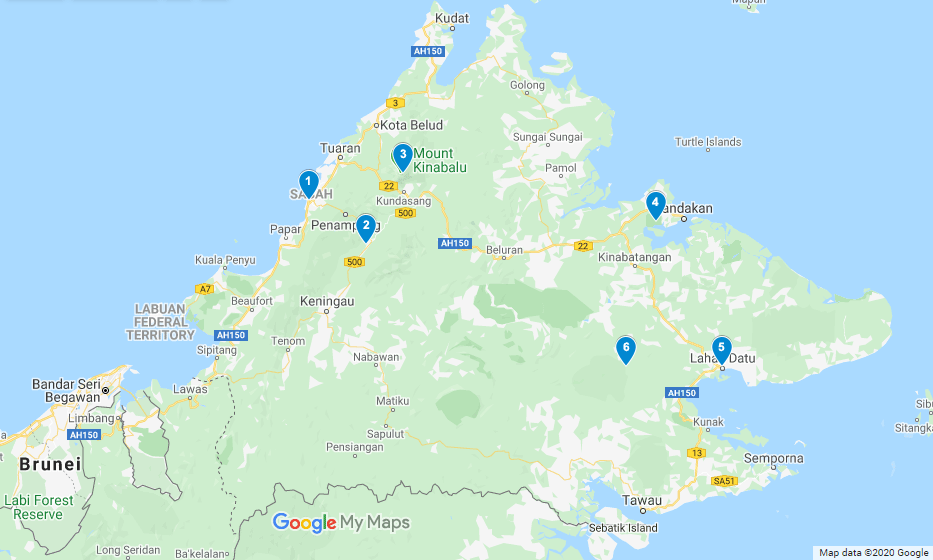
1. Kota Kinabalu International Airport
5. Lahad Datu
2. Tambunan Forest Reserve
6. Danum Valley
3. Mount Kinabalu National Park
4. Sepilok Forest Reserve
The following is a selection of the birds of North Borneo likely to be seen at sites visited on this tour.

Scarlet-rumped Trogon 
Bare-headed Laughingthrush 
Mountain Blackeye 
Bornean Bulbul 
Fluffy-backed Tit Babbler 
Banded Kingfisher 
Bornean Green Magpie 
Mountain Wren Babbler 
Black-and-red Broadbill 
Ferruginous Babbler
All above photographs copyright Nick Upton/Calidris Birding Tours unless otherwise indicated.
Tour Details
Tour Cost: £TBA per person
Single Supplement: £900
Included in the tour cost: All transport including airport transfers, road tolls, national park entry fees, accommodation, all meals, bottled water, boat trips, services of English-speaking birding guide and Calidris Birding Tours guide, services of drivers.
Not included in the tour cost: International flights, travel insurance, visa (most nationalities get visa-free entry for up to 30 days), camera fee at Gomantong Cave (RM 30), alcoholic and soft drinks, tips, laundry, excess baggage fees, hotel mini bar, phone calls and any other items of a personal nature.
Accommodation: The selection of all accommodation is for its convenience to the birding sites. In Kota Kinabalu we stay in a comfortable hotel on the first and last night of this Borneo birding tour. All other accommodation is chosen for its combination of proximity to the birding sites and comfort. All accommodation has private bathrooms and air conditioning. A good internet connection is expected at most accommodations but not all.
Physical effort: The physical effort required on this birding tour to Borneo is not excessive. In fact fairly easy to moderate is how we rate this trip. Participants need to be fit enough to walk along forest trails which have some uneven ground, ascend canopy walkways and walk on some uphill trails on Mount Kinabalu. All walking is done at birding speed.
Weather: In the lowlands we can expect the weather to be hot and humid at all times with some chance of afternoon rain at all locations. However, at the higher elevations at Mount Kinabalu we can expect much milder weather, some cloud and perhaps even some chilly conditions. Again, some rain is possible but prolonged periods are not expected.
Food: The cuisine on this tour is similar to other countries in the region in that a variety of dishes are served at each meal. The food is usually not as spicy as that in other countries in the region and more heavily influenced by Chinese cuisine. Vegetarian food is widely available and most food allergies can be catered for but please let us know beforehand so that we can check that we can provide what you need.
Tour Leaders

Nick Upton
Nick Upton has been birding since the age of seven and leading birding tours full-time since 2007. After travelling extensively in Asia he settled in Thailand in 1997, teaching English and science while establishing thaibirding.com. With a BSc (Hons) Wildlife & Countryside Conservation he is well placed to understand the ecology of birds as well as the conservation issues that affect them.
Nick is co-founder/director of Calidris Birding Tours.

Lee Kok Chung
Lee has been an ourdoor enthusiast his whole life and a professional bird guide since 2003. Lee has extensive birding experience in a wide range of Asian countries and is one of the most proficient and respected bird guides in Malaysia/Borneo. Lee’s organisational skills and professionalism are invaluable in the assured success of the tours he leads for us.
While we will make every effort to adhere to the advertised itinerary for this North Borneo birding tour, we reserve the right to make changes in the case of unforeseen circumstances that are beyond our control. These include problems with accessibility, national park closures, unseasonal weather events or any other reason that may demand an itinerary change.
Recommended Field Guides
 Birds of Malaysia
Birds of Malaysia
Published in 2020 this is both the most complete and up to date field guide covering the birds of Malaysia. Covering Peninsula Malaysia, Sabah and Sarawak this is the most complete and up to date field guide for the birds of this fabulous country. Covered in a flexible and waterproof binding this book is light and travels well.
What we like about this book and others in the series is how it is relevant to all taxonomies and future splits, making our job easier when compiling the checklist!
Read our full review of the book here – Birds of Malaysia.
Related Blog Posts
- Poring Hot Springs – posted by Steve M
Terms and conditions: Please read full Calidris Birding Tours terms and conditions which apply to this North Borneo Birding Tour.




